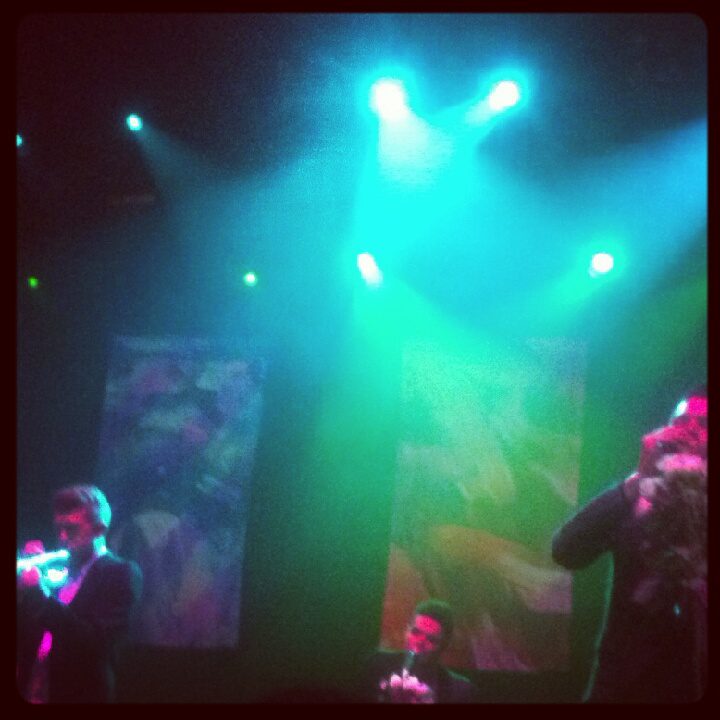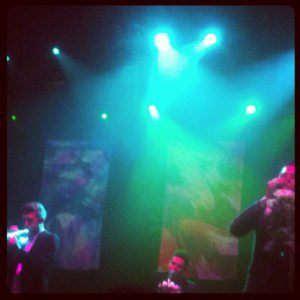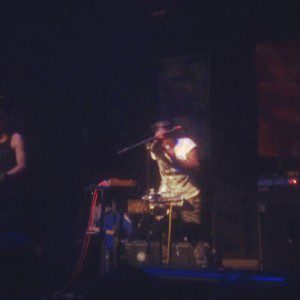
 Watching a Matthew Dear performance is like standing before a work of art from the Italian Renaissance or Greek antiquity. You look at it, beguiled and even frustrated by the possibility that human hands could create something so beautiful. Matthew Dear himself, statuesque and always decked out in an impeccably tailored black suit even when he sleeps, I imagine, has been perfecting this aesthetic, now indistinguishable from the music itself, for over a decade. Going to his show indeed engenders that fleeting and indelible longing you feel when you’re in a museum looking at one of your favorite paintings: a longing to engage with something physically and emotionally unreachable even if by mere inches.
Watching a Matthew Dear performance is like standing before a work of art from the Italian Renaissance or Greek antiquity. You look at it, beguiled and even frustrated by the possibility that human hands could create something so beautiful. Matthew Dear himself, statuesque and always decked out in an impeccably tailored black suit even when he sleeps, I imagine, has been perfecting this aesthetic, now indistinguishable from the music itself, for over a decade. Going to his show indeed engenders that fleeting and indelible longing you feel when you’re in a museum looking at one of your favorite paintings: a longing to engage with something physically and emotionally unreachable even if by mere inches.
The tension of knowing he’s a real person who leads a real life with real things in it, and experiencing him as something so intangible and deliberately cultivated, is gripping. It keeps him shrouded in mystery, and keeps his magnetism as sharp and strong as ever; and it is precisely this tension that made his show last weekend at Webster Hall remarkable.
The stage looked beautiful. Bouquets of white roses embellished every mic stand. Massive banners in the style of abstract expressionism, of Dears most recent album artwork (created by Ghostly’s resident graphic designer, Michael Cina) hung in the background. Each band member juxtaposed one another dramatically, with two sets of percussion sidling the back, the trumpet player front and center, and the bass player in between him and Dear, who, off to the side, performed the electronics, lead guitar and vocals, conducting it all like a circus master. Everyone wore really pretty outfits. They started playing—new and old songs, all of which are so incredibly good— and the audience gravitated toward them like moths to a flame. It felt par for the course.
Then something extraordinary began to happen about halfway through. Maybe it was when he started to peel Rose petals off his bouquet, letting them fall to the floor with an improvised and unlikely touch. Or maybe it was when he started moving around the stage, dancing wildly, and even occasionally jumping off things. I think the decisive moment came, though, toward the end of the song “Do The Right Thing”. The flood lights were turned on so we could all see one another. Dear approached the audience and for the first time ever in my experience, sang the last verse and chorus directly to us, loudly and insistently, without any effects, tracking, or even much help from the band. “I was yours for escape”, he mused. He seemed to be addressing us . He seemed to be shedding his stoic affect in favor of human connection and all the ways in which it leaves one vulnerable as hell. For the last moments of the song he came right up to the edge like he was going to jump, defiantly, not singing just looking. People were generally freaking out. The girl to my right was bawling. As it all ended, he turned and retreated back, disappearing into a haze of smoke, and then the whole room went dark.
He’s clearly trying to make us care about him as a person. The question remains though, how this effort will coalesce with his music, long-associated with his personae, and the ways in which he distances himself from his audience when he’s live. On this, the verdict is still out. I think it says something mighty powerful, however, that his performance of “Do The Right Thing” that night was a singularly moving moment for I suspect, everyone in the room.
The supporting bands, Beacon, Light Asylum (and MNDR which I missed), put on amazing shows. Beacon’s performance was one of the best I’ve seen, since I think their big, cavernous sound is suited for big, cavernous places. The reverb actually had space to travel and linger, and the bass was so loud it had everyone’s hair standing up (the conventional wisdom about chicks loving loud bass is true, by the way). They performed most of their old material from No Body, as well as singles, “So Anxious” and “Last Friday Night”.
Now that they are signed, it seems they’ve come into their own. Thomas Mullarney is more confident in his vocal abilities, and therefore more inclined to sing louder. Even this simple act transforms the songs from good to really really good. For their whole set, they commanded the room–which is no simple feat when there are only two people and zero instruments. Those who were wandering aimlessly about were suddenly captivated. By the end of their set, there were three times as many people huddled toward the front of the stage.
I suspect in the not too distant future, they’ll be the headliners for shows like these.
 When Light Asylum’s set started, I had no idea what to expect. I had only heard of them in passing. Flitting about on stage, plugging in wires was an incredibly muscular, tank top wearing man who I assumed was the band leader. Soon though, a young woman appeared and set my perceptions straight. Not only does she lead the project, she dominates. Their names are Shannon Funchess and Bruno Coviello and they make wildly energetic synthpop with electronic foundations. They’ve released one EP, In Tension, and one self-titled debut. The songs are chaotic and strange, yet entirely danceable. In fact you can’t help but dance when you hear them. This is due to the music itself, of course, but also Funchess’s personality on stage, which demands that you ride along with her on her weird journey. She stands behind an electronic drum kit, and sucks you into her world, sometimes singing or making other types of noises with her voice, sometimes dancing like she’s possessed, sometimes flapping like a bird, etc. And it is extraordinary. She has the lung capacity of a lioness, and a totally unique sounding voice, as well as an unending supply of energy. All this combined with Coviello’s catchy synth makes for the type of new-wave -writ modern I wish so many other mediocre bands would create, but can’t because they simply lack the spirit of innovation it takes to do it. Light Asylum, however, has enough to go around.
When Light Asylum’s set started, I had no idea what to expect. I had only heard of them in passing. Flitting about on stage, plugging in wires was an incredibly muscular, tank top wearing man who I assumed was the band leader. Soon though, a young woman appeared and set my perceptions straight. Not only does she lead the project, she dominates. Their names are Shannon Funchess and Bruno Coviello and they make wildly energetic synthpop with electronic foundations. They’ve released one EP, In Tension, and one self-titled debut. The songs are chaotic and strange, yet entirely danceable. In fact you can’t help but dance when you hear them. This is due to the music itself, of course, but also Funchess’s personality on stage, which demands that you ride along with her on her weird journey. She stands behind an electronic drum kit, and sucks you into her world, sometimes singing or making other types of noises with her voice, sometimes dancing like she’s possessed, sometimes flapping like a bird, etc. And it is extraordinary. She has the lung capacity of a lioness, and a totally unique sounding voice, as well as an unending supply of energy. All this combined with Coviello’s catchy synth makes for the type of new-wave -writ modern I wish so many other mediocre bands would create, but can’t because they simply lack the spirit of innovation it takes to do it. Light Asylum, however, has enough to go around.









